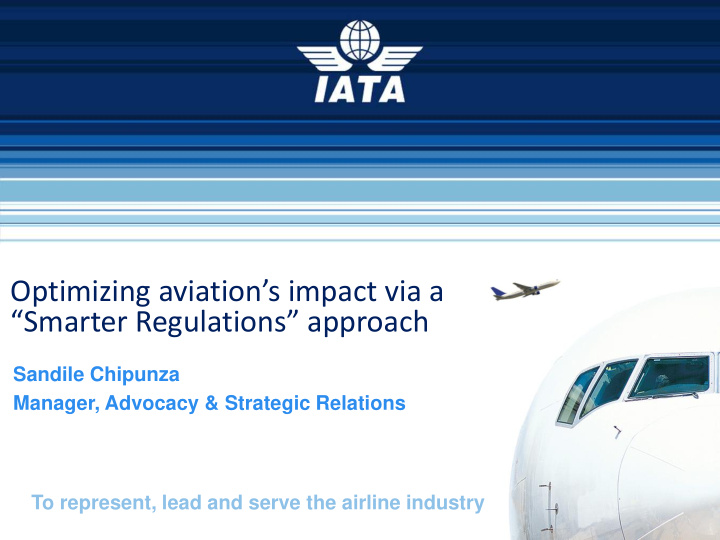



Optimizing aviation’s impact via a “Smarter Regulations” approach Sandile Chipunza Manager, Advocacy & Strategic Relations To represent, lead and serve the airline industry
IATA IN B RIEF Global trade association for the world’s airlines 290 passenger and cargo carriers 84% of global air traffic Meeting our members’ needs
Aviation as a Force for Good…
The Business of Freedom
Aviation as a key economic enabler
Demand for air travel to double over the next 20 years Global passengers (billion, O-D basis) 11 Constant policies scenario 10 A Pick-up in Protectionism 9 Policy stimulus and market liberalization 8 6.9bn 7 6 5 4 3.5bn 3 2 2017 2019 2021 2023 2025 2027 2029 2031 2033 2035 2037 Source: IATA/Tourism Economics www.iata.org/economics 6
Regional profitability remains very uneven Net post-tax profit margins 10% 8% 2015 2016 2017 2018 6% 4% 2% 0% -2% -4% -6% N America Europe Asia Pacific Middle East L America Africa Source: IATA Economics using data from ICAO, The Airline Analyst, IATA forecasts
Regional (net) profitability – Africa US$bn 0.5 2% 0.0 0% -0.5 -2% -1.0 -4% Net profit (Left axis) -1.5 -6% Net profit margin (Right axis) -2.0 -8% 2008 2009 2010 2011 2012 2013 2014 2015 2016 2017 2018f Source: IATA www.iata.org/economics 8
What does African aviation need? 1. Continuous improvement in Safety and Security 2. The full implementation of the Single Africa Air Transport Market (SAATM) 3. Regulatory & policy harmonization Optimized infrastructure – ground and air 4. 5. Ease of intra-African mobility (Visas/customs) 6. Reduce taxes and charges - competitiveness 7. Human capacity development 8. Multi-sector collaboration
What do we mean by “smarter regulation?” Smart regulation is regulation that promotes and enables the growth and sustainability of any industry. It delivers clearly defined, measurable policy objectives in the least burdensome way.
What it means…. • Partnership with governments that will results in well- designed regulations • Recognition of similar effective initiatives launched by some governments and regulators • Incorporation of best practices and global standards • Achieve efficient policy outcomes that avoid unintended consequences. • A set of common sense principles
Smarter Regulation: Core Design Principles • Consistency and coherence • Proportionality • Targeted at risk • Fair and non-distortive • Clarity and certainty
Smarter Regulation: Core Process Principles • Addresses a clear need • Impact assessment • Consultative • Transparent and objective • Reduces compliance burden • Regular review • Appeal
Focus: Regulatory Impact Assessment (RIA) • A tool used to examine and measure the likely benefits, costs and effects of government policies • An analytical framework for decision making: Clear identification of the underlying policy problem and specific options for addressing that problem. Organizes and consolidates a menu of options for decisions at early stages of policy development Provides an objective and transparent basis and criteria for decision making
Focus: Consultation • Public participation can help governments understand stakeholders’ needs and ensure their feedback is considered. • Consultation should be done at the earliest stages of the policy development process and if possible at various stages so that it helps governments collect data and the results can be used effectively. • European Commission: “listen more closely to citizens and stakeholders, and be open to their feedback, at every stage of the process – from the first idea, to when the Commission makes a proposal, through to the adoption of legislation and its evaluation”.
RIA & Consultation together reinforce best practice • Affected stakeholders are in a unique position to contribute to an accurate cost-benefit analysis, as well as identify unintended consequences • Aviation example: imposition of new taxes and charges • Consultation on RIA efforts therefore critical to share the burden and create an accurate picture of regulatory costs • Timing of RIA & Consultation also critical as proposals can change during the legislative process
The benefit of hindsight (or an impact assessment)…
Where do we need a smarter regulation approach in African aviation? The policy framework which underpins aviation development • Safety & Security • Connectivity • Airline repatriation of funds • Infrastructure • Environment • Taxation, etc
The impact of a favourable regulatory environment in Africa Increased tourism New routes and frequencies Air traffic Increased Shorter trade travel Improving growth time Connectivity Lower Inward fares Investment Source: Intervistas
SAATM Priority Implementation Plan 2018/2019 Key Issues for Consideration 1. Pillar 1: Advocacy for Effective Operationalisation of the SAATM 2. Pillar 2: SAATM Regulatory Framework 3. Pillar 3: Operationalization of SAATM 4. Pillar 4: SAATM infrastructure 5. Pillar 5: SAATM- Enhancing Safety and Security Pillar 6: SAATM – Financing the Aviation Industry 6.
Key Takeaways • Efficient and effective regulation supports quality of life, social cohesion and the rule of law • Smarter regulations: Helps achieve policy objectives at minimum cost Ensures that policy is prepared, implemented and reviewed in an open, transparent manner Supports regulations that are in the best interest of the public, justified, effective and transparent • Stakeholders are in the best position to inform government policies Avoiding unintended consequences Expanding options for efficient regulatory choices
Thank you
Recommend
More recommend